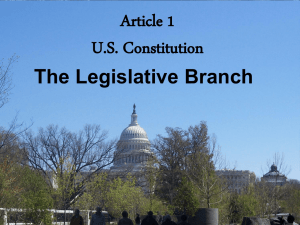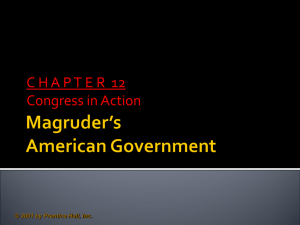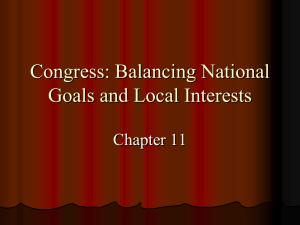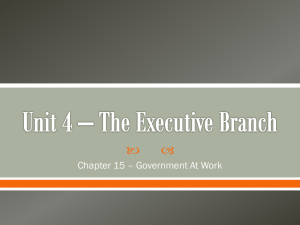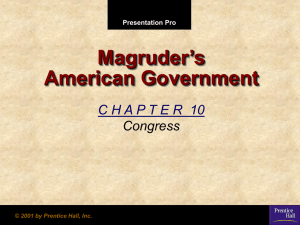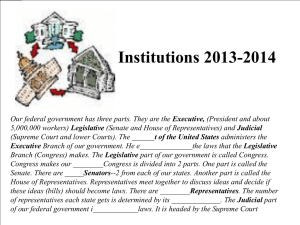House & Senate: Differences in Representation
advertisement
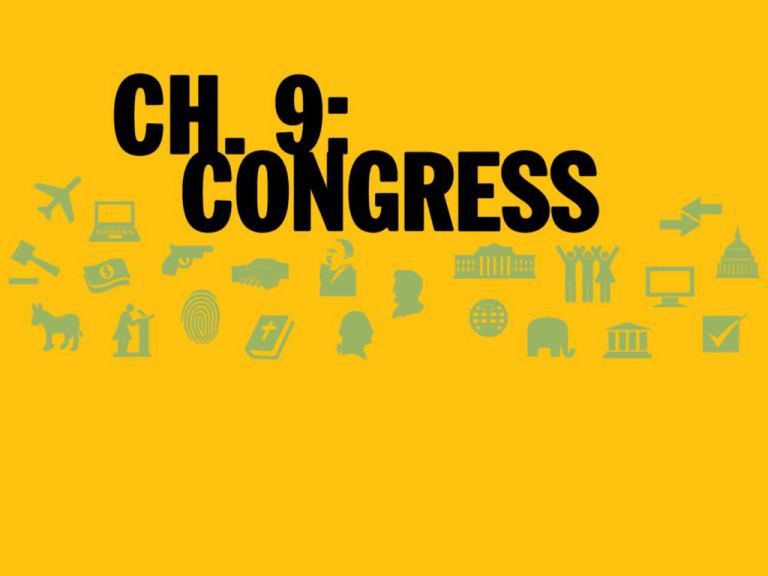
Congress House & Senate: Differences in Representation • Bicameral System: Two Chambers – Each state has two senators – Representation in the House determined by state population – Predicated on different models of representation • Senate: states, with long terms • House: districts, with short terms House & Senate: Differences in Representation • Senate: 100 Senators – Originally selected by state legislatures – Six year terms • House of Representatives: 435 Members – Elected by districts – Two year terms House & Senate: Differences in Representation • How representatives “represent”: – Sociological Representation: Representative shares characteristics, background and interests with constituents – Agency Representation: Representative has incentives to act in the constituents’ interests House & Senate: Differences in Representation • Sociological Representation House & Senate: Differences in Representation • Representatives as Agents: Legislators learn about the interests of constituents • Parties almost never ask a member of Congress to vote against constituent interests The Electoral Connection • Who gets elected? – Incumbency advantage – Districting and gerrymandering issues The Electoral Connection • Incumbency Advantage – Members of Congress have an array of tools to keep them in office • Constituency services • Name recognition and title The Power of Incumbency The Electoral Connection • Redistricting – The vast majority of incumbents in safe seats come from districts where the majority of voters are from the same party as they are – The critical election in these districts is the primary – Gerrymandering: Redrawing legislative district boundary lines to provide political advantage or disadvantage Results of Congressional Reapportionment The Electoral Connection • Direct Patronage – Pork barrel spending • Earmarks – Patronage • Some local and state elected officials have jobs to offer to constituents – Constituent services – Private bills The Electoral Connection The Organization of Congress • Majority party controls leadership and shapes agenda – Speaker of the House is the leader of majority party – Both parties also elect a majority leader, a minority leader, and a whip – Parties determine which of their members sit on various committees Party Leadership in the Senate Majority Party Structure in the House of Representatives Majority Party Structure in the Senate The Organization of Congress • Committee System – Standing committees – Select committees – Joint committees – Conference committees The Organization of Congress • Standing committees are permanent and are where the majority of legislation is written The Organization of Congress The Organization of Congress • Select Committees – Formed temporarily to focus on a specific issue • Cannot present bills to the chamber • Bring attention to a specific subject The Organization of Congress • Joint Committees – Formed from members of both Chambers – Gather information – Cover issues internal to Congress The Organization of Congress • Conference Committees – Temporary joint committees – For a bill to become a law, the same wording of the bill must be passed by both chambers – Conference committees are formed to write the final wording when both chambers pass similar bills that need to be reconciled The Organization of Congress • The number of seats the minority party has on a committee is roughly proportionate to the seats it has in the House, but at an unfavorable rate. • Seniority determines committee assignments – Chairs can be removed by the party caucus – Chairs are term-limited The Organization of Congress • Congressional Staffers – Members of Congress need staff who are experts in specific fields and also staff to help constituents • Over 11,500 staff in DC and district offices • Another 2,000 staff for committees How a Bill Becomes a Law How a Bill Becomes a Law • A bill is a proposed law that has been sponsored by a member of Congress and submitted to the Clerk of the House or Senate • The bill is given a number and assigned to a committee, which typically refers it to a subcommittee • Bills taken seriously are given a hearing Rules of Lawmaking Explain How a Bill Becomes a Law How a Bill Becomes a Law • The House rule determines how much time is allocated for floor debate. • The debate time is divided equally between those for the bill and those against the bill. • The Senate allows for unlimited discussion, requiring 60 votes to end a filibuster via cloture. How a Bill Becomes a Law • Once a bill clears in one chamber, it is sent to the other, where the process starts over. • If both chambers pass the same wording, the bill is sent to the president. • If not, both chambers create a conference committee. How a Bill Becomes a Law • The President is given ten days to veto a law. – Vetoes can be overridden by a two-thirds vote in each chamber. – Pocket veto: If there are less than tens days left in the Congressional calendar and the president does not sign the bill into law, it dies and must begin again from scratch in the next session. How Congress Decides • There are a number of influences on members of Congress. • Constituents – Legislators take constituents seriously if they believe it will affect their support at the next election. How Congress Decides How Congress Decides • Interest Groups – Can supply legislators with information about pending bills – Can make donations – Do they represent the interests of constituents? How Congress Decides • Party Discipline – Congress has become bitterly partisan since the 1990s How Congress Decides • Party leaders have some tools at their disposal: – Leadership PACs – Committee assignments – Access to the floor – The whip system – Logrolling – Presidency Beyond Legislation • Oversight – Congress is expected to oversee the activities of the Executive Branch in order to ensure funding is spent properly and laws are enforced. Beyond Legislation • Advice and Consent – Senate must confirm top-level executive appointments, ambassadors, and federal judges – Must also approve all treaties Beyond Legislation • Impeachment – If high officials are thought to have committed “Treason, Bribery or other High Crimes and Misdemeanors,” they can be impeached. – The House acts as a grand jury. – The Senate conducts the actual trial. Public Opinion Poll Do you approve or disapprove of the way Congress is handling its job? a) b) c) d) Strongly approve Approve Disapprove Strongly disapprove Public Opinion Poll Do you approve or disapprove of the way your member of Congress is handling his or her job? a) b) c) d) Strongly approve Approve Disapprove Strongly disapprove Public Opinion Poll Do you believe we should have term limits for Members of Congress? a) Yes b) No Public Opinion Poll Do you believe state legislatures should consider the racial makeup of a district when redistricting? a) Yes b) No Public Opinion Poll Do you think it is important that the demographics of Congress represent the social, racial and economic demographics of the country? a) Yes b) No Public Opinion Poll When members of Congress cast a vote, which of the following factors should typically most influence their decision? a) The interests of the country as a whole b) The interests of their district or state Public Opinion Poll Which of the following do you believe should be the most influential factor in the voting decisions of members of congress? a) The preferences of their constituents b) The preferences of the President c) The preferences of the Members’ Party Leadership d) The members’ own ideology Chapter 9: Congress • Quizzes • Flashcards • Outlines • Exercises wwnorton.com/we-the-people Following this slide, you will find additional images, figures, and tables from the textbook. Differences between the House and the Senate The Social Composition of the U.S. Congress Party Discipline Get Your Representatives in Congress Working for You Debate

